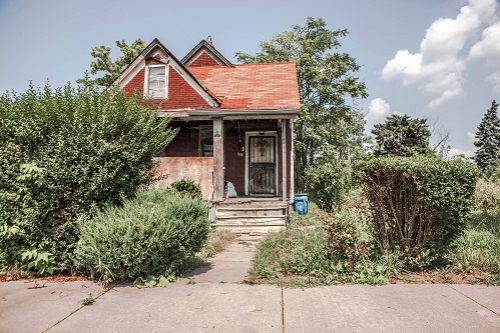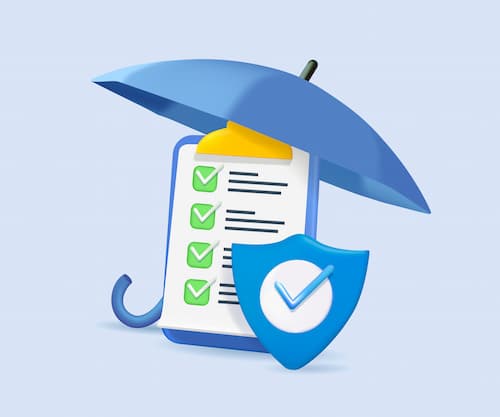- Does homeowners insurance cover flooding?
- How does flood insurance work?
- What is the flood insurance deductible?
- What does flood insurance cover?
- What isn’t covered by flood insurance?
- Who needs flood insurance?
- How much is flood insurance?
- How to buy flood insurance
- How to file a flood insurance claim
- Myths and Facts: Flood insurance
- FAQ: Flood insurance
Does homeowners insurance cover flooding?
Homeowners insurance does not cover damage from flooding unless the flooding originated within the home or from the sky as rainfall through damage to the structure. It covers water damage from bursting pipes and overflowing toilets, sinks and tubs. It usually covers the costs if your dishwasher or water heater explodes.
However, your homeowners insurance doesn't cover damage caused by flooding from creeks, rivers, or lakes or flash flooding caused by rain or a storm surge. In those cases, you need a flood insurance policy.
How does flood insurance work?
Flood insurance works like any other insurance policy; you pay a premium and the policy covers you up to the stated limits.
Flood policies are primarily sold through the National Flood Insurance Program (NFIP), although you can also buy them from private insurers. Unlike most other types of insurance, flood policy rates don't vary if the policy is through the NFIP.
Also, unlike standard homeowners insurance, flood insurance doesn't kick in immediately when you sign up. That prevents you from buying a policy as a storm heads your way. There's a 30-day waiting period in most cases.
However, there are a few exceptions:
- If your address was newly added to the SFHA map and you're buying flood insurance within the 13 months following a map revision.
- If you're renewing your flood policy and increasing your coverage.
- If your home is affected by flooding on burned federal land and you buy a policy within 60 days of the fire's containment.
- If you just bought a house and your lender requires flood coverage.
If you wait until the rainy season to buy your flood policy, you could be trapped in a nightmare scenario: having purchased insurance but being ineligible for coverage if a storm hits within a month. For maximum peace of mind, it may be best to "set it and forget it."
Otherwise, flood insurance is a lot like standard home insurance (but does not replace standard home insurance). You'll pay a premium to the insurance company for the policy annually, and if you file a claim, you'll pay your deductible out-of-pocket before the company kicks in to pay the rest.
What is the flood insurance deductible?
A flood policy has two deductibles: one for the building and its contents. You typically get to choose the deductible amount. Common flood deductibles range from $1,000 to $5,000.
As with other types of insurance, a higher deductible on your flood policy will result in a lower premium; however, if you have a mortgage, your lender may not allow you to increase your deductible beyond specified limits.
People ask
How is flood insurance calculated?
The cost of flood insurance is calculated based on the flood risk in your location and the flood insurance coverage limits you need.
What does flood insurance cover?
Flood insurance covers losses directly resulting from flooding or flood-related erosion caused by heavy or prolonged rain, snowmelt, coastal storm surges, blocked storm drainage systems, levee dam failure and similar events.
Flood insurance through the NFIP covers the following on your home:
- The insured building and its foundation.
- The electrical and plumbing systems.
- Central air-conditioning systems, furnaces and water heaters.
- Refrigerators, stoves and built-in appliances like dishwashers and trash compactors.
- Permanently installed carpeting and flooring.
- Permanently installed paneling, wallboard and built-in bookcases and cabinets.
- Window blinds and shutters.
- Detached garages (up to 10% of structural coverage). Other outbuildings require separate policies.
- Debris removal.
In addition, flood insurance covers damage and loss of personal property as follows:
- Clothing, furniture and electronics.
- Curtains and window treatments.
- Portable and window air-conditioners.
- Portable microwave ovens, dishwashers and other small appliances.
- Rugs.
- Clothes washers and dryers.
- Food freezers and the food in them.
- Valuables like artwork, jewelry and furs (up to $2,500).
If you have a lot of valuables, ask your insurer about additional riders or endorsements to extend your flood coverage.
The FEMA flood insurance guide is also a helpful resource that details claims, coverage and costs.
Flood insurance coverage limits
The NFIP lets you insure your house for up to $250,000 and your personal property (contents) for up to $100,000. If you rent, you can buy up to $100,000 in coverage for your belongings. For non-residential property, you can buy up to $500,000 of coverage for the building and contents.
Private flood insurance coverage limits vary but are often much higher than what the NFIP offers.
People ask
How much flood insurance do I need?
You need enough flood insurance coverage for the replacement cost of your home and all of its contents. If you need more coverage than is available with an NFIP policy, you can buy supplemental coverage or shop for a private flood insurance policy.
What isn’t covered by flood insurance?
An NFIP policy does have limitations, some of which differ if you buy private flood insurance.
Flooding in the first 30 days
Standard flood insurance plugs many holes in your homeowners policy, but it's not foolproof. NFIP coverage will not kick in if purchased less than 30 days before the occurrence of flood damage.
"We always encourage people to educate themselves on what their home's risk might be, and talk to their insurance agent well before there's a storm on the horizon or any type of flooding situation that would come up," says Christina Loznicka, a spokesperson for Allstate Insurance in Northbrook, Illinois.
Private flood insurance waiting periods vary.
Damages exceeding policy limits
Federal flood insurance coverage is capped at $350,000 -- $250,000 for your dwelling and $100,000 for your personal possessions. If your house or the property is valued at more than those limits, you could be at risk of being underinsured.
To protect yourself and your belongings, it's important to determine if you need additional coverage, says Loznicka. Ask your insurance agent if you're eligible to purchase excess flood insurance, which private insurers offer.
Such policies can provide up to several million dollars of extra coverage. To buy supplemental private flood insurance, policyholders must purchase NFIP coverage before buying the extra coverage, which has widely varying premium rates.
You can also buy a standalone flood insurance policy from a private company if you need more coverage.
Damage to finished basements
Under NFIP guidelines, a basement is defined as any area of a building that has its floor below ground level on all sides, says Racusen.
Flood insurance doesn't cover cosmetic improvements to basements. So, if storm-related flooding damages new furniture or carpeting, it will not be covered. Neither will damage to things like new sinks or bathtubs.
In the event of a flood, a standard homeowners insurance policy won't cover those damages either, Racusen says. You'll have to pay out-of-pocket if you don't have special endorsements or riders.
Many private flood insurance companies do cover finished basements.
Landscaping and exterior features
You're out of luck if a flood takes out your trees or plants. Also excluded are features like fountains, decks, patios, walkways, fences, hot tubs, swimming pools, wells and septic systems.
Additional living expenses
If your home becomes unlivable after a flood, your insurance will not cover the cost of alternative living arrangements. While your standard homeowners policy includes this for other disasters, it doesn't apply to flooding. Most private flood insurance companies offer this coverage.
Other flood insurance exclusions
Other items excluded from flood coverage include:
- Damage caused by moisture, mildew, or mold that you could have prevented
- Currency, precious metals, and valuable papers like stock certificates
- Financial losses caused by the loss of use of the property
- Vehicles
Who needs flood insurance?
You need flood insurance if you live in a flood zone and your mortgage company requires it. However, flood insurance is important for nearly everyone, even outside flood zones.
- Mortgage lenders require homebuyers in designated flood plains (aka Special Flood Hazard Areas, or SFHAs) to purchase flood insurance. You're not required to get flood insurance if you don't live in a flood zone and have a mortgage.
- The NFIP reports that about 25% of flood insurance claims are filed outside of high-risk flood zones.
- Without insurance, disaster relief from floods mostly takes the form of the federal government's low-interest loans. These loans must be paid back. Purchasing a flood insurance policy is the only way to protect yourself from flood-related costs.
People ask
How much will FEMA pay for flood damage?
The average FEMA assistance grant for a flood is between $3,000 and $6,000. This assistance is not part of a flood insurance policy; an NFIP policy covers up to $250,000 for the home and $100,000 for contents.
How much is flood insurance?
Based on the most recent data, flood insurance costs an average of $1,169 for an NFIP policy.
Flood insurance cost depends largely on your home's risk. If your home is located in a low-to-moderate risk area, you're eligible for Preferred Risk Policy (PRP) rates. How much you pay depends on whether you have a basement or not and the amount of building and contents coverage you choose. The rates will be much higher if you live in a high-risk area.
Here are the average flood insurance rates by state based on the most recent data:
| State | Average annual cost |
|---|---|
| Alaska | $893 |
| Alabama | $843 |
| Arkansas | $845 |
| Arizona | $650 |
| California | $940 |
| Colorado | $924 |
| Connecticut | $1,408 |
| District of Columbia | $761 |
| Delaware | $860 |
| Florida | $544 |
| Georgia | $798 |
| Hawaii | $580 |
| Iowa | $974 |
| Idaho | $795 |
| Illinois | $1,048 |
| Indiana | $950 |
| Kansas | $902 |
| Kentucky | $913 |
| Louisiana | $777 |
| Massachusetts | $1,259 |
| Maryland | $678 |
| Maine | $1,085 |
| Michigan | $975 |
| Minnesota | $944 |
| Missouri | $1,023 |
| Mississippi | $842 |
| Montana | $796 |
| North Carolina | $964 |
| North Dakota | $761 |
| Nebraska | $1,081 |
| New Hampshire | $1,052 |
| New Jersey | $1,014 |
| New Mexico | $846 |
| Nevada | $798 |
| New York | $1,237 |
| Ohio | $941 |
| Oklahoma | $831 |
| Oregon | $907 |
| Pennsylvania | $1,148 |
| Rhode Island | $1,358 |
| South Carolina | $689 |
| South Dakota | $809 |
| Tennessee | $873 |
| Texas | $698 |
| Utah | $600 |
| Virginia | $834 |
| Vermont | $1,493 |
| Washington | $889 |
| Wisconsin | $1,043 |
| West Virginia | $1,070 |
| Wyoming | $883 |
Source: National Flood Insurance Program
How much is flood insurance in a flood zone?
For those in higher-risk areas (Zones V and A), flood insurance cost depends on your home's size, construction, location and your deductible.
The Base Flood Elevation, or BFE, shown on the Flood Insurance Rate Map (FIRM) for high-risk flood zones indicates the water surface elevation resulting from a flood with a 1% chance of equaling or exceeding that level in any given year.
Increasing your home's elevation is the primary way to reduce your flood insurance cost. Going from four feet below the BSE to three feet above would save over $90,000 in 10 years at today's premiums. Homeowners may be able to get low-cost loans or grants to accomplish this.
The other way to lower costs is to increase your deductible. The minimum deductible for flood insurance is $1,000, and the maximum is $10,000. You can save up to 40% on your premiums by increasing your deductible.
For those in the riskiest areas, the savings realized by increasing to a $10,000 deductible would make up the added cost in less than three years.
How to buy flood insurance
Before you buy, decide whether you want an NFIP plan or a private flood policy.
If you buy an NFIP plan, you can buy it directly or from a standard home insurance company. Standard home insurance companies administer Write-Your-Own policies, though NFIP still backs them and pays claims. The NFIP has a list of home insurance companies that participate in the Write-Your-Own program.
Because the price for NFIP policies is standard, there is no comparison shopping. So, the only issue is how much coverage to buy. Coverage amounts are capped at $250,000 for your dwelling and $100,000 for your possessions, so if your home and its contents are worth less, you can buy lower limits, which would cost less.
Private flood insurance can supplement or replace an NFIP policy, providing coverage for the house, outdoor property, detached structures, swimming pools and basements. You can purchase a policy by contacting these companies, finding out what coverage limits are offered, and ensuring you get limits high enough to cover your home and personal possessions.
Private flood insurance policies have varying limits, up to $15 million. So be sure to compare policies with limits that best match the value of your home and its contents. Like standard home insurance, compare identical coverage limits to see who offers the best price.
Where to buy flood insurance
You can buy flood insurance directly from the NFIP, from an insurance company that sells NFIP policies or from a company that offers private flood insurance. Our ranking of the best flood insurance companies is a good place to start, but here are a few options to consider:
- Chubb offers standalone flood insurance and supplemental or excess coverage that works with an NFIP plan.
- Wright Flood Insurance offers stand-alone flood insurance in Florida, New Jersey and South Carolina.
- Flood Guard insurance is available as primary or supplemental flood insurance in Arizona, California, Illinois, Indiana, Nevada, Oklahoma, Oregon, Pennsylvania, South Carolina and Utah.
- TypTap offers flood insurance in California, Florida, Maryland, New Jersey, Pennsylvania, South Carolina and Texas.
Pros and cons of private flood insurance
There are both pros and cons to choosing private flood insurance over an NFIP policy.
Pros:
- Higher coverage limits
- Replacement cost coverage for personal property
- Additional coverage options like loss of use and basement coverage
Cons:
- May be more costly (although that cost comes with more coverage)
- Not backed by FEMA
- Some flood insurance companies haven't been around enough to have a strong reputation
How to file a flood insurance claim
A flood insurance claim is much like any other insurance claim. Follow these steps to get a claim started.
1. Contact your insurer as soon as possible. All flood insurance policies require you to give timely written notice of loss. Have your policy number and a phone number and/or e-mail address where you can be reached.
2. Separate your damaged and undamaged property. Don't dispose of anything before an adjuster has seen it unless required by law. If you have to get rid of anything (for instance, mold-infested carpet), take pictures and keep samples of the damaged goods (a small piece of the carpet).
You need to do whatever you can to prevent further damage and protect undamaged property. Still, you'll want to consult with your flood adjuster before hiring anyone to do repairs.
3. Compile a list of damaged personal property. It's smart to create a list before flooding, so all you have to do is check off the damaged items. The list should have an item description, cost, model and serial number (when applicable), and estimated dollar loss. Include any receipts, photos, and warranties you have.
4. Detail structural damages. Note structural loss/damage to point out to the insurance adjuster. Your adjuster will usually contact you within 24-48 hours after being notified of your loss. Then, they will come to view your property. You may ask the adjuster for an advance or partial payment. If you have a mortgage, your mortgage company must sign the building property advance check.
5. Complete a Proof of Loss statement containing the information required by your flood insurance policy within 60 days after the loss. The Proof of Loss includes a detailed estimate to replace or repair the damaged structure and contents. In most cases, the adjuster can provide you with a suggested Proof of Loss.
Your claim is payable after you and the insurer agree on the amount of damages, and the insurer receives your complete, accurate and signed Proof of Loss in support of your claim.
Tips for filing flood claims in Texas and Florida
Texas and Florida often get hit hard by hurricanes.
If you live in Texas, you may be interested in learning about the “blue tarp law.” It’s often considered an anti-consumer law and one that favors insurance companies. That’s because, well, it does make life easier for insurance companies. Here’s a quick overview of related issues and stipulations:
- Cuts interest on unpaid claims for which the insurance company is found liable from 18% to 8%.
- Requires attorneys to file a notice letter with an insurance company more than 60 days prior to a lawsuit being filed. The letter must explain details that justify the claim as well as the amount of damages suffered.
- Lawsuits filed without the prior notice letter will be abated or delayed; the intent is it will provide time to satisfy the notice letter provision.
- The notice provision allows inspection of the property and provides additional time for insurance companies to avoid litigation by settling the dispute.
- In addition to insurance claims for flood damage, the law applies to claims for damage connected to hailstorms, earthquakes, wildfires, tremors, tornadoes, lightning and wind, snow and rain storms.
Meanwhile, in Florida, hiring a public adjuster is likely worthwhile. The insurance company's adjuster will decide your final claim payout amount. You can hire a public adjuster to negotiate on your behalf when filing your claim, or you can bring one in if you disagree with the amount set by your insurance company’s adjuster. Some key tips about public adjusters:
- Most public adjusters charge a percentage of the settlement, usually between 5 and 12%.
- Generally, public adjusters benefit homeowners filing complex claims for significant damage costing more than $10,000.
- Hiring a public adjuster at the beginning of the claims process will save time; hiring one at the end can add an extra month or so to the time frame for settling a claim.
- Policyholders with public adjuster representation typically received higher settlements than those without public adjusters.
When would a flood insurance claim be denied?
- You don’t have flood insurance. A flood claim against a homeowners policy will be denied as it doesn't include flood coverage.
- The damage was pre-existing. Maybe your insurer suspects that the mold on your basement walls occurred long before the flood, and you’re just using the flood as an excuse to get your basement repaired.
- The water damage was caused by something other than a flood. Water damage from burst pipes, for example, is not covered by flood insurance.
- You're still in a waiting period. NFIP policies have a 30-day waiting period, and private flood varies. Damage from a flood in that time period is not covered.
- The damage was in your basement. NFIP policies limit or exclude damage in a basement; a private flood policy may offer this coverage.
How can I appeal a flood insurance claim?
According to FloodSmart.gov, the federal website run by the NFIP (National Flood Insurance Program), you have four options.
- Work with your insurance company to resolve differences
- File an appeal with FEMA or through the appropriate channels with a private flood insurer
- Request that appraisals be done to determine the cost of the damage
- File a lawsuit
Myths and Facts: Flood insurance
Myth #1: Homeowners insurance covers flood damage.
Fact: Standard homeowners insurance does not cover flood damage. You need a separate flood insurance policy, either through the National Flood Insurance Program (NFIP) or a private insurer to be protected.
Myth #2: Flood insurance is too expensive.
Fact: The cost of flood insurance depends on factors like location, home elevation, and flood risk. In some areas, policies can cost as little as a few hundred dollars per year—far less than paying out-of-pocket for flood damage.
Myth #3: I can buy flood insurance right before a storm hits.
Fact: Most flood insurance policies have a 30-day waiting period before they take effect. If you wait until a storm is approaching, it’s too late to get coverage.
Myth #4: Flood insurance only covers my home, not my belongings.
Fact: Flood insurance can cover both your home and personal belongings, depending on your policy. Coverage typically includes structural damage, appliances, furniture, electronics, and even clothing.
FAQ: Flood insurance
How much flood insurance do I need?
You need enough flood insurance to cover the replacement cost of your home and your personal property. You may need to turn to private insurance to get enough coverage.
Can I get flood insurance if I have filed flood insurance claims in the past?
Yes, you can get flood insurance if the property has been flooded previously. Your premium will likely reflect the added risk of subsequent flooding.
Can you pay flood insurance monthly?
Not with an NFIP policy, which must be paid in full. Private companies usually accept monthly payments.
My home and contents are worth more than $350,000. Can I buy additional coverage?
Yes, either through supplemental coverage or a private policy.
Is my house in a flood zone?
Flood zones are mapped nationwide. You can enter your address into the flood risk tool provided by FEMA to see your local risk profile.
Can you get flood insurance if you are not in a flood zone?
Yes. Anyone can buy flood insurance.




